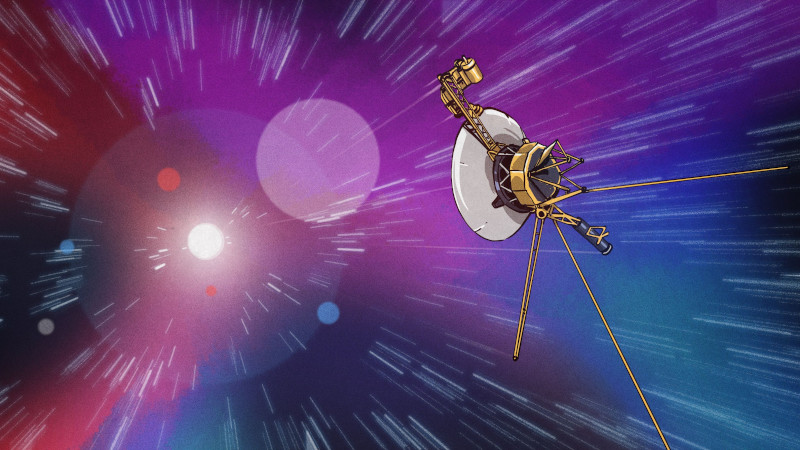🫡
I try to diagnose the carburetor in my 50 year old Jeep sitting right in front of me, and I still can’t get it running right.
These people are amazing, and the people that built that so it can still be fixed out in the Oort Cloud were even better.
People will believe anything lol
V’ger has evolved
That’s far out!
It’s literally the most far out object there is
It is just incredible to me that we have the ability and knowhow to send instructions to a 40 year old transistor computer to reprogram itself and get it working again with just radio signals.
Incredible is the right word, how does this still work after more than 47 years? How do they even still have energy to send and receive signals? That’s one heck of a durable power source. How do the computers and sensors still work? The reliability and durability of these probes is amazing. NASA truly had some reality wizards doing what seems like magic to accomplish this.
Either that or, aliens have been helping out and repaired it from time to time.
Fuck aliens
How do they even still have energy to send and receive signals? That’s one heck of a durable power source.
It’s literally decaying plutonium-238. And because it decays, it’s putting out less power than when it started. They’ve shut down certain operations to conserve power, and obviously prioritize things like communication back to earth.
How do they even still have energy to send and receive signals?
They’re apparently on their last legs now.
The Voyagers have enough electrical power and thruster fuel to keep its current suite of science instruments on until at least 2025.
They’ve been on their last legs for decades now
47 year old probe. Damn near 50
Same. That was incredible.
What they did was close to wizardry.
With no way to fix the chip, the team instead split the code up so it could be stored elsewhere. Initially they focused on reacquiring the engineering data, sending an update to Voyager 1 on 18 April 2024.
It takes 22.5 hours for a radio signal to travel the 24 billion kilometres (15 billion miles) out to Voyager 1, and the same back, meaning the spacecraft’s operations team didn’t receive a message back until 20 April.
But when it arrived, they had usable data from Voyager 1 for the first time in five months.
https://www.skyatnightmagazine.com/space-missions/how-fixed-voyager-1
Here’s a fun fact that I think of every time I read about light delay.
We assume the speed of light is the same in all directions but there’s no way to prove that it is.
It could be light speed is instantaneous in one direction, and half the speed we think it is in the reverse. Any test we could devise depends on information traveling in two directions, nullifying any discrepancies in light speed.
Couldn’t we send out two devices in different directions, wait a decade, have them shine light at eachother simultaneously, record when they receive the light, then send the times back to earth?
Your question is a good one. It indicates that you don’t have an understanding of time dilation and frame of reference. An explanation of the theory of relativity is pages long.
The first book I ever read on the subject, and IMO the best introductory text for any non-physiscist, is Stephen Hawking’s “A Brief History of Time”. But, any introduction to relativity should answer your question.
Another interesting way to conceptualize it is that the speed of light is infinite and it’s causality/information that is limited to c. You shine a light at the moon and it takes 1.3 seconds for the “fact” that the light was turned on to propagate that far.
Cixin Liu imagines exactly that towards the end of the Three Body series. Among other things, which make the series worth absolutely slogging through at points.
The speed of light in a vacuum unaffected by external forces such as gravity should be the same no matter what direction it is in. I’m not sure why it wouldn’t be. That’s like saying a kilometer is longer if you go East than if you go West.
However, it’s actually far more complicated than that, and much of it beyond my understanding.
https://math.ucr.edu/home/baez/physics/Relativity/SpeedOfLight/speed_of_light.html
That said, direction should not matter.
There’s no reason it wouldn’t be. The point is that it’s impossible to prove that it is. There is no conceivable experiment that can be performed to prove the two-way speed of light is symmetric.
That’s not how anything works. It’s impossible to prove that the universe wasn’t created last Thursday with everything in place as it is now. There’s no point in assuming anything that can’t be proven has validity.
…but that’s exactly what you’re doing. The fact that light travels at the same speed in all directions cannot be proven. You’re the one insisting that it does.
It’s just a thought exercise. There are several reputable YouTube videos on this topic. None of them claim that the speed of light isn’t the speed of light. They’re just demonstrating that we can’t prove it with current technology. Similar to the difficulty it took to finally prove that one plus one equals two. We know that’s correct, but it took years to prove it.
… but there is a way, and it has been proven.
One of the more memorable physics classes I’ve had went into the history of discoveries that led to our understanding of relativity. The relevant story here, starts with how sound travels though air.
Let’s say you’re standing at the bottom of a building shouting to your friend peeking out a window on the 5th floor. On a calm day, that friend will hear you at pretty much the same time as someone standing the same distance away, but on the street. However, if it’s windy, the wind pushes around the air through which the sound of your voice is traveling, the friend up in the window will have a slight delay in receiving that sound. This can of course be verified with more scientific rigor, like a sound sent in two perpendicular directions activating a light.
Scientist at the time thought that light, like sound, must travel though some medium, and they called this theoretical medium the Aether. Since this medium is not locked to Earth, they figured they must be capable of detecting movement of this medium, an Aether wind, if you will. If somehow the movement of this medium caused the speed of light in one direction to be faster than another due to the movement of this medium, measuring the speed in two directions perpendicular to each other would reveal that difference. After a series of experiments of increasing distances and measurement sensitivities (think mirrors on mountain tops to measure the time for a laser beam to reflect), no change in the speed of light based on direction was found.
Please enjoy this wikipedia hole: https://en.m.wikipedia.org/wiki/Michelson–Morley_experiment , and please consider a bit of caution before you refer to things as facts in the future!
How does the double slit experiment work into this?
Provided we engineer them well, this is good news for truly deep space operations. Cosmic radiation and interplanetary gasses could (and probably do) wreak havoc on various materials, but apparently technology from the 70s is capable of handling it very long term.
Now if we could just get out of these squishy meat suits we’d be in business.
Solid state tech using minerals and metals for interstellar travel.
Squishy meatbag for living and reproducing on a goldilocked planetoid.
We should just turn into comets for the purpose of travelling 🐌 slow but effective
o7
Just curious: is the data of value for research or is it more like “look at us, we can repair from a distance”?
It’s the only instrumentation we have at that distance that can measure things like solar irradiance.
Interesting question though, which sent me down a rabbit hole to see the capabilities of the instrumentation.
I like to follow it through space
Yes the data is valuable for research. You and I may not understand any of it, but its useful to someone. As for repairing from a distance, that thing has been traveling for 46 years and gone far. For reference, it passed Neptune back in 1989.
It would take many years for a new probe to reach those distances, so if it can be repaired, it shall.
https://en.m.wikipedia.org/wiki/Voyager_2
Hypothetically, lets say it only takes 30 years for a new probe with updated tech to reach where Voyager 2 is now. If V2 died today, thats half of someone’s career spent waiting for the new probe to arrive. Multiply that by everyone using the probe for research and you have a ton of wasted potential.
I’m aware that sending something to do the repairs isn’t an option, my question was whether it’s worth it (and apparently it is) or if it’s more an experiment about long distance repairs which by itself is very expressive already.
I’m not sure why I’m downvoted. Maybe I worded my question badly or it’s because it was a question I could have googled on my own. I don’t know and neither do I care. I don’t think you downvoted me, if it sounded that way. Just now saw it and wondered why
Remote software repairs are definatly good, pretty cool and worth bragging about. If you have to do a physical repair, you’re probably better off just sending a new probe [citation needed], but as I said the time investment is huge.
It is a legitimate question, however the way it was asked has a negative vibe, intentional or not. You pretty much gave a good option and bad option and said “pick one” - generally when that’s asked, we assume the asker assumes the negative is true (it’s hard to explain). To me, it could be interpreted as “just curious, I assume this probe is only taking pretty pictures, so why do you bother repairing it?”.
Personally, I’ve been trying to avoid jumping to those types of conclusions. Text has no tone, and phrases sometimes have a secondary tonal meanings that people will insert. “Just curious…was it you that didn’t refill the coffee machine this morning?”
Thanks, I’m not good at tone in my native language already and even less in English. I didn’t give the comment much thought, I could have found a better phrasing.
About the coffee machine: I refilled it today so it must have been someone else who didn’t
Voyager 2 went with a different trajectory specifically to fly by the outer planets. Voyager 1 went with a more aggressive gravity assist from both Jupiter and Saturn to gain the speed necessary to leave the solar system. So it’s not only that it takes decades to get that far, but also the launch window of when different planets are aligned to make the mission feasible.
There are currently five science investigation teams participating in the VIM. The science teams for these investigations are currently collecting and evaluating data on the strength and orientation of the Sun’s magnetic field; the composition, direction and energy spectra of the solar wind particles and interstellar cosmic rays; the strength of radio emissions that are thought to be originating at the heliopause, beyond which is interstellar space; and the distribution of hydrogen within the outer heliosphere.
There are 4 operating instruments on-board the Voyager 1 spacecraft. These instruments directly support the five science investigations teams. The Planetary Radio Astronomy Investigation (PRA) is no longer working on the Voyager 1 spacecraft and the Ultraviolet Spectrometer Subsystem (UVS) is no longer working on Voyager 1 or Voyager 2.
What’s the baud rate and have they needed to adjust it over time?
Not baud, but actual data rate returned:
https://voyager.jpl.nasa.gov/mission/science/
Science data are returned to earth in real time at 160 bps
That “real time” on out of earth scale always boggles my mind. Technically it is as fast as it possibly could, knowing that radio waves travels at the speed of light. But damn, that light has to travel for a long time before arriving so “real time” data that arrives is technically “quite old” data.
As far as it is, it’s still just under one day at light speed.
Imagine the ping & jitter…oh…god…
The latency to Voyager 1 is apparently a bit under 23 hours, so yeah, that’s gonna be painful.
I’d guess that the jitter is probably zero.
Like, if they can pull data in realtime, I assume that they’ve chosen an encoding with enough redundancy that data can get through reliably at that rate. Because of the latency, they’d have to have a huge buffer if they wanted to have some protocol that required frequently requesting retransmits.
this detecation is impressive.
I’m constantly amazed at the longevity of this probe, so awesome!
It’s like the Jason Vorhees of spacecraft












